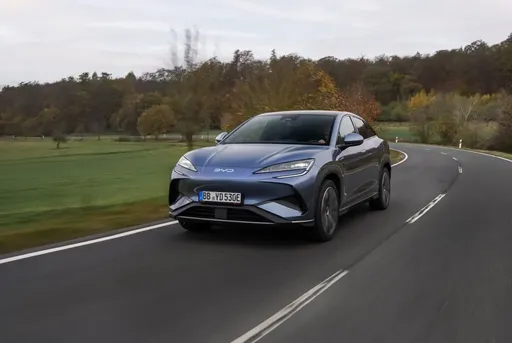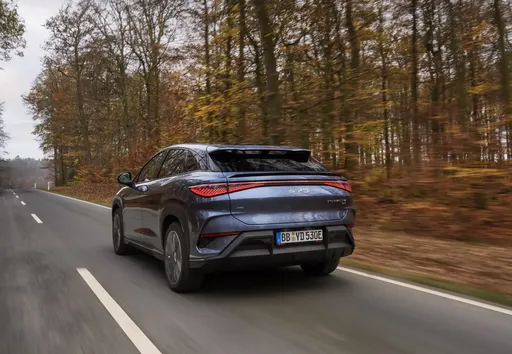As the automotive market continues to shift towards electrification, two contenders are emerging in the SUV segment: the SERES 5 and the BYD Sealion 7. Both of these electric vehicles (EVs) offer impressive performance, innovative features, and sustainable driving solutions. In this comparison, we delve into their technical specifications, design elements, and innovative technologies to help you decide which model stands out in this increasingly competitive field.
SERES 5 vs BYD Sealion 7 – Which model is better for everyday use?
Two cars, one duel: SERES 5 meets BYD Sealion 7.
Which one wins in performance, efficiency and value for money? Find out now!
Performance and Powertrain
Starting with performance, the SERES 5 boasts a powerful all-wheel drive system with a remarkable output of 646 HP (475 kW) and torque reaching 940 Nm. This engine configuration allows it to accelerate from 0 to 100 km/h in just 4.1 seconds, marking it as one of the high-performance electric SUVs available.
On the other hand, the BYD Sealion 7 offers three different powertrain configurations, producing between 313 HP (230 kW) and 530 HP (390 kW). With a maximum torque ranging from 380 Nm to 690 Nm, the Sealion 7 can go from 0 to 100 km/h in as little as 4.5 seconds for the most powerful variant. It also features both rear-wheel and all-wheel drive options, enhancing its versatility for various driving conditions.
Range and Efficiency
When it comes to electric range, the BYD Sealion 7 holds an advantage. Its multiple configurations offer an electric range between 456 km and 502 km, providing plenty of distance for long drives. In comparison, the SERES 5 has a range of up to 430 km, which is still impressive for an SUV in its class.
In terms of energy consumption, the SERES 5 consumes 18.6 kWh/100 km, while the Sealion 7 ranges from 19.9 kWh/100 km to 21.9 kWh/100 km, depending on the variant. Although the Sealion 7's consumption is slightly higher, its extended range may justify the trade-off for potential buyers prioritizing distance.
Design and Interior Space
Both vehicles exhibit contemporary SUV designs, but they cater to different aesthetics. The SERES 5, with its clean lines and futuristic appeal, measures 4700 mm in length, 1930 mm in width, and 1625 mm in height. It provides adequate trunk capacity of 367 liters for everyday use.
Conversely, the BYD Sealion 7 is slightly larger at 4830 mm in length and offers a wider trunk capacity of 520 liters, accommodating more luggage and cargo. This extra storage could be especially beneficial for families or those who frequently travel.
Technological Innovations
In today's market, technology plays a vital role in the overall appeal of a vehicle. The SERES 5 stands out with its all-wheel drive capability and robust acceleration, making it a thrilling option for performance-oriented buyers.
Meanwhile, the BYD Sealion 7 introduces a reduction gearbox in its transmission, enhancing driving efficiency and performance. Coupled with its diverse power options, this feature may attract buyers looking for versatility in their electric SUV.
Conclusion: Which One to Choose?
Deciding between the SERES 5 and the BYD Sealion 7 ultimately comes down to personal preferences and priorities. The SERES 5 offers unparalleled power and performance, making it an exciting choice for driving enthusiasts. In contrast, the BYD Sealion 7 provides greater range and practicality with its larger trunk space, making it suitable for families and those who require additional cargo capacity.
Both vehicles exemplify the advancements in electric vehicle technology and design. As the market continues to evolve, potential buyers should consider their specific needs and test drive both options to see which SUV resonates more with their lifestyle.
Here’s where it gets real: The technical differences in detail
Costs and Efficiency:
Price and efficiency are often the first things buyers look at. Here it becomes clear which model has the long-term edge – whether at the pump, the plug, or in purchase price.
BYD Sealion 7 has a distinct advantage in terms of price – it starts at 42800 £, while the SERES 5 costs 57300 £. That’s a price difference of around 14494 £.
In terms of energy consumption, the advantage goes to the SERES 5: with 18.60 kWh per 100 km, it’s minimal more efficient than the BYD Sealion 7 with 19.90 kWh. That’s a difference of about 1.30 kWh.
As for range, the BYD Sealion 7 performs to a small extent better – achieving up to 502 km, about 72 km more than the SERES 5.
Engine and Performance:
Power, torque and acceleration say a lot about how a car feels on the road. This is where you see which model delivers more driving dynamics.
When it comes to engine power, the SERES 5 has a slight edge – offering 585 HP compared to 530 HP. That’s roughly 55 HP more horsepower.
In acceleration from 0 to 100 km/h, the SERES 5 is hardly perceptible quicker – completing the sprint in 4.10 s, while the BYD Sealion 7 takes 4.50 s. That’s about 0.40 s faster.
In terms of top speed, the BYD Sealion 7 performs barely noticeable better – reaching 215 km/h, while the SERES 5 tops out at 200 km/h. The difference is around 15 km/h.
There’s also a difference in torque: SERES 5 pulls noticeable stronger with 940 Nm compared to 690 Nm. That’s about 250 Nm difference.
Space and Everyday Use:
Cabin size, boot volume and payload all play a role in everyday practicality. Here, comfort and flexibility make the difference.
Both vehicles offer seating for 5 people.
In curb weight, BYD Sealion 7 is minimal lighter – 2225 kg compared to 2360 kg. The difference is around 135 kg.
In terms of boot space, the BYD Sealion 7 offers distinct more room – 520 L compared to 367 L. That’s a difference of about 153 L.
In maximum load capacity, the BYD Sealion 7 performs clearly better – up to 1789 L, which is about 1066 L more than the SERES 5.
When it comes to payload, BYD Sealion 7 minimal takes the win – 410 kg compared to 375 kg. That’s a difference of about 35 kg.
Who comes out on top?
Overall, the BYD Sealion 7 shows itself to be leaves the rival little chance and secures the title of DriveDuel Champion.
It convinces with the more balanced overall package and proves to be the more versatile choice for everyday use.

BYD Sealion 7
SERES 5
The latest iteration of the Model 5 showcases a refined design that seamlessly blends elegance with sportiness. Its spacious interior and cutting-edge technology make it a top choice for drivers seeking both comfort and performance. With impressive efficiency and a commitment to sustainability, the Model 5 sets a new standard in the electric vehicle market.
detailsBYD Sealion 7
The Sealion 7 captivates with its striking design and impressive performance that appeals to both enthusiasts and casual drivers alike. With a focus on comfort and advanced technology, this model redefines the driving experience, making every journey enjoyable. Its sleek silhouette coupled with an innovative interior showcases the perfect blend of style and functionality.
details @ BYD
@ BYD
 @ BYD
@ BYD
 @ BYD
@ BYD

|
|
|
|
|
Costs and Consumption |
|
|---|---|
|
Price
57300 £
|
Price
42800 - 52300 £
|
|
Consumption L/100km
-
|
Consumption L/100km
-
|
|
Consumption kWh/100km
18.60 kWh
|
Consumption kWh/100km
19.9 - 21.9 kWh
|
|
Electric Range
430 km
|
Electric Range
456 - 502 km
|
|
Battery Capacity
-
|
Battery Capacity
-
|
|
co2
0 g/km
|
co2
0 g/km
|
|
Fuel tank capacity
-
|
Fuel tank capacity
-
|
Dimensions and Body |
|
|---|---|
|
Body Type
SUV
|
Body Type
SUV
|
|
Seats
5
|
Seats
5
|
|
Doors
5
|
Doors
4
|
|
Curb weight
2360 kg
|
Curb weight
2225 - 2435 kg
|
|
Trunk capacity
367 L
|
Trunk capacity
520 L
|
|
Length
4700 mm
|
Length
4830 mm
|
|
Width
1930 mm
|
Width
1925 mm
|
|
Height
1625 mm
|
Height
1620 mm
|
|
Max trunk capacity
723 L
|
Max trunk capacity
1789 L
|
|
Payload
375 kg
|
Payload
410 kg
|
Engine and Performance |
|
|---|---|
|
Engine Type
Electric
|
Engine Type
Electric
|
|
Transmission
Automatic
|
Transmission
Automatic
|
|
Transmission Detail
Reduction Gearbox
|
Transmission Detail
Reduction Gearbox
|
|
Drive Type
All-Wheel Drive
|
Drive Type
Rear-Wheel Drive, All-Wheel Drive
|
|
Power HP
585 HP
|
Power HP
313 - 530 HP
|
|
Acceleration 0-100km/h
4.10 s
|
Acceleration 0-100km/h
4.5 - 6.7 s
|
|
Max Speed
200 km/h
|
Max Speed
215 km/h
|
|
Torque
940 Nm
|
Torque
380 - 690 Nm
|
|
Number of Cylinders
-
|
Number of Cylinders
-
|
|
Power kW
430 kW
|
Power kW
230 - 390 kW
|
|
Engine capacity
-
|
Engine capacity
-
|
General |
|
|---|---|
|
Model Year
2024
|
Model Year
2024
|
|
CO2 Efficiency Class
A
|
CO2 Efficiency Class
A
|
|
Brand
SERES
|
Brand
BYD
|
What drive types are available for the SERES 5?
Available configurations include All-Wheel Drive.
The prices and data displayed are estimates based on German list prices and may vary by country. This information is not legally binding.
